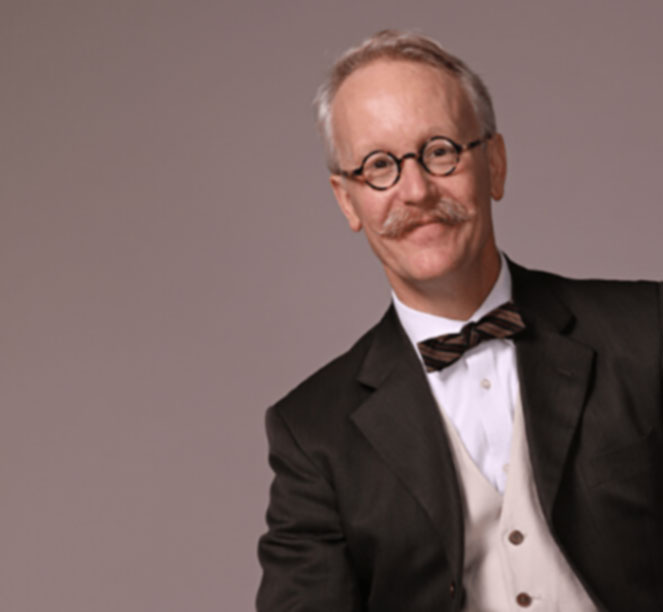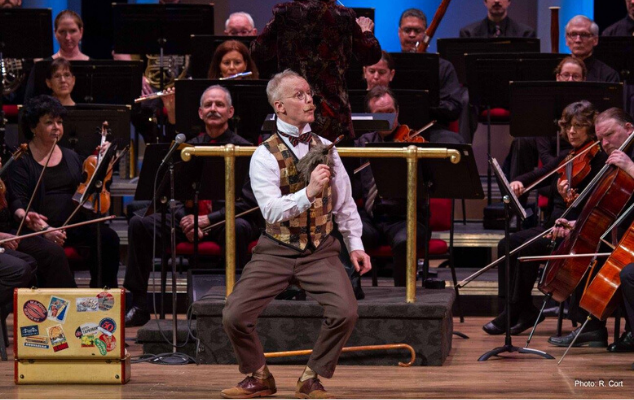Michael Boudewyns

Michael Boudewyns
A Really Inventive Career - Michael Boudewyns and his Orchestral Odyssey
by Eric Lange
Peter and the Wolf.
The Story of Babar.
The Toy Symphony.
The Young Person’s Guide to the Orchestra.
Tubby the Tuba.
Green Eggs and Ham.
What do all these titles have in common? Well, they’re children’s favorites, to be sure. But they’re also some of the titles that drive UNI graduate Michael Boudewyns’ (1989) creative life and livelihood.
At UNI, Michael says he was drawn to invent performances. “I had a lot of creative freedom in college. It was fun and playful, but I also took away really useful lessons. I was always interested in figuring out how to use my creativity and enthusiasm. Teachers like Gretta, Tom Carlisle, and Jay Edelnant helped me do that. I was allowed and encouraged to devise performances.”
“Gretta Berghammer helped me develop a one-person show with some juggling, and some mime — which I brought to elementary schools.” Michael recounts how Gretta — who has always worked as an advocate for the arts in schools — helped him figure out how to do effective outreach. Michael credits the wide range of experiences he had at UNI for much of his success. Michael recalls a particularly helpful bit of advice from Jay. He was working on a project for a performance class. He sat in the Acting Practice Room (now the Phelps Acting Practice Room) frustrated because the scene needed a small tree, and he didn’t know how to get one. Jay explained to him that you don’t need the actual thing – just something that represents it, like a tree made from newspaper.
Michael draws upon many theatre experiences at UNI (main stage shows, classes, studio series, summer theatre), andcredits them as the beginning of the path that led to what he does today: creating pieces of theatre for young audiences that he and his wife (Sara Valentine, who he married in 2005) devise and perform with orchestras across North America. He attended graduate school at the PTTP (Professional Theatre Training Program) at the University of Delaware. “I was part of the first PTTP class at the University of Delaware. The PTTP was originally located in Milwaukee, WI – but the University of Delaware brought the entire grad program there in 1989. It was focused, demanding, and intense. I loved it.” Michael graduated from the PTTP in 1992. Michael’s wife Sara also received her degree from PTTP in 2007. She is currently the Chair of Theatre at the University of Southern Maine.
After graduate school, Michael went to Baltimore to help friends from PTTP start the Baltimore Shakespeare Festival. It was then that the primary focus of Michael’s current work started. It started with museums. “Wilmington, Delaware, had a children’s museum, and I pitched the idea of a touring theatre production" based on an exhibit about the physics of sound. They said yes. He created a Danny Kaye-inspired Austrian science professor (a character that Michael would use many more times in the future) to tell the science story, and toured the Mid-Atlantic states.
His next museum stop was the Delaware Art Museum. Michael approached them about making a show for the museum. They were not interested initially, but later called him when they had an exhibit of illustrations from children’s books. The museum invited him to read a story or two; instead, Michael designed a performance. Michael drew inspiration from Sesame Street and Elmo’s World, which he watched with his kids. He designed a Buster Keaton/Charlie Chaplin-type outfit with a suitcase, an easel, and a golden frame. Out comes one book at a time, placed in the gold frame on the easel, and then Michael performs the story like a monologue – classic children’s books, such as Madeline by Ludwig Bemelmans , and Harold and the Purple Crayon by Crocket Johnson. The performance ended with Goodnight Moon by Margaret Wise Brown. The families were invited to recite along – they did enthusiastically.

Michael then started getting calls from elementary schools. He devised longer performances. The Delaware Art Museum continued to ask Michael to create performances for them. One time they had an exhibit of the works of John Tenniel, the original illustrator of Alice in Wonderland. Michael memorized Chapter 7 (the iconic mad tea-party) and invented a performance using a chair, a coffee table and three hats: one for the Mad Hatter,
one for the March Hare, and one for the Dormouse. He was narrator of a virtuoso one-person tea party, switching hats as he went from character to character.
One of the head librarians for the Delaware Division of Libraries happened to see him perform this piece. They hired Michael to tour to all thirty-four libraries in the state. Every summer for ten years, Michael memorized seven or eight books and toured to libraries throughout Delaware, Pennsylvania, Maryland and New Jersey. During this time he also established a connection with Enchantment Theatre Company in Philadelphia – a company that incorporates magic into their shows – and worked on projects like “The Sorcerer’s Apprentice”, in which Michael played the Sorcerer’s Apprentice with the Philadelphia Orchestra as part of their
100th birthday celebration.
In 2003, the Philadelphia Orchestra was looking for a host for a family concert featuring movie music, and asked Michael to audition. They wanted people to audition with a story. Michael arrived with the suitcase and his Keatonesque garb. He saw a rich diversity of people from all sorts of different backgrounds: African-American, Native American, and Chinese-American storytellers. Michael began to feel that maybe he wasn’t what the orchestra was looking for.
He auditioned with The Cat in the Hat by Dr. Seuss. He knew people make a judgment within a minute. He expected to get cut off, but they let him perform the entire ten-minute story – and they hired him! Michael was invited to pitch playful ways to introduce various pieces of music in a family concert with the Philadelphia Orchestra. The orchestra picked what ideas they liked, then Michael crafted those ideas into a performance that went great. This was the beginning of a long partnership. Michael has performed with the Philadelphia Orchestra for twelve seasons, and has toured to Vail, Colorado, twice with them.
That relationship led to an invitation to a New Jersey orchestra to perform Sam-I-Am in Green Eggs and Ham. There were only two rehearsals and no stage director – only the orchestra, a soprano, and Michael. “I quickly invented how to stage it, and figured out the choreography and the costumes. With only two rehearsals, I didn’t know how to memorize an orchestra score, so I drew hieroglyphics in my Green Eggs and Ham book to remind me of physical cues during the music.” It went great, so much so that they invited him back to do “The Story of Babar”. Michael improvised it with a box of props. The orchestra loved it, and extended another invitation: Peter and the Wolf. Michel and Sara knew there was a lot at stake for something delightful to show up. In 2005, they sat down and designed a solo piece of vaudeville-inspired theatre. They used a suitcase, a feather duster, a baseball hat, a yellow silk, and toilet plungers. Throw in a coat rack, two stools, and piece by piece they “invented” how to perform Peter and the Wolf as the orchestra played. Since 2004, in addition to performing numerous family concerts, Michael and Sara have invented at least one similar orchestra project each year. They are given full artistic license for design, staging and performance. Their company, called Really Inventive Stuff, also includes another performer who grew up in Iowa - soprano Kimberly Schoreder. (Sara Valentine proudly grew up in Massachusetts.)
In 2007, Michael started reaching out to other orchestras. The Richmond Symphony Orchestra in Virginia, and the Annapolis Symphony Orchestra in Maryland responded and booked Really Inventive Stuff. Other orchestras followed suit across the country, as well as in Canada, England and Singapore. When planning a season, orchestras might program “Tubby the Tuba” or “The Young Person’s Guide to the Orchestra” without knowing who the narrator will be. Michael tracks this, and inquires if they’d be interested in hiring Really Inventive Stuff. About half of the 51 orchestras they work with started with a cold contact.
Today, they have eleven productions in their repertoire that they tour and perform. Eleven productions that they’ve created in their studio and rehearsal space: their house. “It’s easy to think that if you don’t have a space that looks exactly a certain way you are unable to create props or costumes or rehearse – and that if you don’t have this or that you can’t do it – but the truth is you can create anything wherever you want!”
In March, Michael was supposed to have traveled to Jacksonville to perform Peter and the Wolf. As with most live events across the country, the show was canceled due to the COVID-19 pandemic. Happily, the 2020-21 season is booking orchestra performances in Milwaukee, Detroit, Saint Louis, Richmond, Jacksonville, New Hampshire and New Jersey. Michael offers some advice for today’s Theatre students:
“Go attend events. As a college student, I made the mistake of being a ‘selfish egotistical performer.’ I own that. There were numerous productions in the Music Department — I did not go see them. I wasn’t cast in Cabaret
— I did not go see it. I didn’t go to orchestral or jazz concerts. I didn’t go to art exhibitions. I didn’t go to readings in the English department. Take advantage of the creative things happening at UNI. You never know what you might be able to draw upon.”
“Also, don’t wait for someone to hire you to receive permission to use your creativity. Start inventing now, in college. You only need to be courageous. In order to have a lifelong, fulfilling career you’ll need to take ownership of your imagination, and start doing and devising. UNI has facilities and amazing faculty that are available to you right now.
“Finally, even though you’re busy – DO YOUR HOMEWORK. If you are a creative person who has a career, you will always have homework. You’re going to need to figure out rent, gas, cell phone AND how to do your research, practice your instrument and learn your lines. Life will never be less busy — just filled with different activities.Developing a work habit in college is one of the useful tools you’ll need no matter what you do. For example, every day I review my orchestra music and texts. These are compositions I’ve performed since 2004,and I know them by heart; but I still review pieces every morning for two hours as part of my routine to begin each day.”
Michael has created a class he delivers at the University of Southern Maine that explores where inspiration comes from, and how you keep “refilling your well” across your whole life as a creative person. It seems he’s been very successful doing just that.
